In professional basketball, success is not just about talent and tactics. Fatigue, travel demands, and game scheduling play a decisive role. Especially in leagues like the NBA or EuroLeague, where teams can play multiple games within a few days and cover thousands of kilometres in a week, the calendar can be as tough as any opponent. This article delves into how back-to-back games and extended road trips affect team performance, shooting accuracy, and overall game outcomes, with a special focus on data relevant to February 2025.
Physical Fatigue and Its Impact on Scoring
Back-to-back games – matches played on two consecutive days – remain a scheduling staple in many basketball leagues. Players are expected to maintain peak performance levels with minimal recovery time. Physiological stress accumulates, affecting muscle response, reaction time, and cardiovascular endurance. These factors often translate into lower scoring percentages, especially in the second game of a back-to-back series.
February 2025 data from both the NBA and EuroLeague confirms this pattern. Teams averaged 7–9% fewer points per game on the second night of back-to-backs compared to single-rest games. Moreover, three-point shooting accuracy dropped by nearly 4%. These numbers reveal a consistent trend across multiple teams, regardless of their position in the standings.
Interestingly, individual player fatigue varies. Starters, who typically play more minutes, see steeper declines in output. Bench players, however, sometimes step up in these circumstances, potentially due to being better rested. This underlines the strategic depth that teams must consider when managing rotations during intense scheduling periods.
Two to Three Games in Three Days: A Statistical Breakdown
One of the most punishing schedules is playing two to three games in three days. In such scenarios, average team efficiency metrics drop substantially. For example, in February 2025, teams playing 3 games in 72 hours showed a 6.8% decline in offensive rating, while defensive lapses increased, as evidenced by higher opponent shooting percentages.
These effects compound when travel is involved. Crossing time zones, particularly for teams based in the western United States or Russia, adds circadian rhythm disruption to the mix. This impacts both physical recovery and mental alertness. The outcome? Slower transitions, weaker rebounding, and reduced defensive intensity.
Such conditions disproportionately impact veteran teams. Age correlates with recovery speed, and experienced squads often struggle more with such schedules unless they implement heavy rotation and load management strategies.
Home vs Away: The Role of Travel and Venue Familiarity
Long road trips are an endurance test, especially when paired with back-to-back games. Away teams face unfamiliar courts, hostile crowds, and irregular routines. Data from February 2025 reveals that visiting teams on multi-city road trips scored an average of 6.2 fewer points than in home games. Turnover rates also increased by 8%.
Home teams benefit not just from rest, but also from routine. Familiar locker rooms, predictable schedules, and crowd support improve player focus. These psychological edges accumulate, particularly when the visiting team is fatigued. Hence, home advantage is statistically amplified during opponents’ road trips or second games in a series.
Another overlooked factor is altitude and climate. Playing in cities like Denver or Belgrade introduces physiological challenges that further hinder teams unused to such environments. Recovery tools like cryotherapy or compression gear offer only partial mitigation under compressed schedules.
Comparison of Domestic and International Travel Effects
Teams that travel internationally – such as EuroLeague squads or NBA franchises on global tours – face even more disruption. Border crossings, passport control delays, and varying food and training standards pose extra hurdles. February 2025 analysis shows international road teams losing by an average margin of 11.3 points versus rested home squads.
Domestic road trips, while still challenging, offer more logistical consistency. Charter flights, standardised hotel protocols, and familiar cities ease the toll. Therefore, betting models often adjust more sharply for international fatigue effects than for domestic ones.
For bettors, distinguishing between the two travel types is crucial. Mispricing commonly occurs when bookmakers underestimate international fatigue or overrate short-road-trip resilience. These edges offer subtle opportunities for well-informed predictions.

Bookmakers and Bettor Strategies
Bookmakers have grown increasingly sophisticated in modelling fatigue. Adjusted team totals, point spreads, and even first-half betting lines often reflect projected drop-offs due to compressed schedules. However, market inefficiencies persist. Sharp bettors exploit situations where line adjustments lag behind team news or travel insights.
For example, when a top scorer is rested for game two of a back-to-back, but sportsbooks have not adjusted the total accordingly, there’s clear value. Similarly, following insider reports about delayed travel or disrupted shootarounds can highlight underpriced opportunities, particularly in live betting markets.
As of February 2025, data from several betting exchanges show increased accuracy in second-leg predictions, but with notable variance during prolonged road trips. Bookmakers seem to rely heavily on historical models, occasionally ignoring recent injury reports or under-the-radar travel complications.
How Bettors Can Gain an Edge
To gain an edge, bettors should track team schedules in detail. Tools that aggregate travel kilometres, rest days, and minute load for key players provide valuable insights. Moreover, comparing team performance trends across similar scheduling scenarios – such as road back-to-backs versus home back-to-backs – reveals exploitable tendencies.
Live betting also offers chances to spot fatigue in real-time. Sluggish starts, early foul trouble, or unusual substitution patterns can indicate tired legs. These in-play moments often shift momentum and create windows for profitable wagers before oddsmakers adjust.
Finally, trust verifiable data over assumptions. Public narratives about fatigue are often overstated or vague. Instead, focus on actual performance metrics, recent travel logs, and trusted insider reports. The blend of sharp analytics and situational awareness remains the hallmark of profitable basketball betting.
